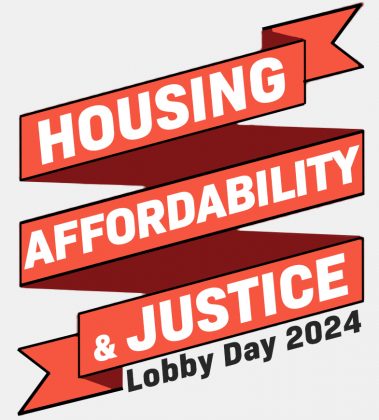
Housing Affordability & Justice Lobby Day provides a unique platform for participants to learn, engage, and advocate for positive change in Nebraska’s housing landscape. Join us in amplifying the voices calling for housing justice and working towards a more equitable, accessible, and affordable future for all.
This event concluded at noon on March 13, 2024.
Lobby Day highlights Nebraska’s housing affordability crisis – Civic Nebraska
Lawmakers urge housing advocates to stay hopeful – Lincoln Journal Star
Senators, advocates rally for housing rights – KOLN-KGIN
‘Housing is a human right’: Advocates rally at Capitol – KETV
Housing advocates converge at State Capitol – Nebraska Examiner

9 to 10 am:
Learn!
Our day will start with sessions that cover a broad spectrum of advocacy topics. This will include an introduction to advocacy, a review of relevant bills before the Legislature, and insights into tenant rights and housing development in Nebraska.
Advocacy training
Option 1: FULL
‘Advocacy 101’ for FIRST-TIME Lobby Day Participants
Lincoln Community Foundation, 215 Centennial Mall South

Have breakfast with us at LCF headquarters, which is roughly two blocks north of the State Capitol, to learn advocacy basics. Learn how to “pull” senators from the floor; get information about key tenant protection and housing legislation in the Legislature this year; and prepare key talking points. After breakfast and training, we’ll walk in a group to the Nebraska State Capitol promptly at 10 am. Route
* Please get in touch with Lizzie Turner at lturner@neappleseed.org if you would benefit from a ride to the Capitol instead of walking.
_______
Option 2: SPACE STILL AVAILABLE
Advocacy Breakfast and Discussion
Roman Hruska Law Center, 635 S. 14th St., Suite 200
 Connect over breakfast with experienced advocates to discuss focus bills and prepare for the day. After breakfast and discussion, we’ll walk in a group to the Nebraska State Capitol promptly at 10 am.
Connect over breakfast with experienced advocates to discuss focus bills and prepare for the day. After breakfast and discussion, we’ll walk in a group to the Nebraska State Capitol promptly at 10 am.
10:30 to 11 am:
Engage!
Next, we’ll all share in the public highlight of Lobby Day: a news conference featuring notable speakers, community leaders, and policymakers. Join us as we build awareness about our campaign to bring housing affordability to our state.

News conference
Nebraska State Capitol, Hearing Room 1524.
Join fellow advocates, state senators, tenants, members of the media, and others for comments about Lobby Day and the need for housing affordability and justice in our state.
11 am to noon:
Advocate!
Finally, we’ll put our new skills to work by pulling senators to talk about our focus bills, using many of the messages that we crafted earlier in the morning. And we’ll also stand to be recognized in the gallery by state senators on the statehouse floor.

Recognition and advocacy
Nebraska State Capitol
~ 11 am CDT
Norris Chamber gallery
Observe floor debate from the gallery and receive recognition from state senators on the floor of the Nebraska Legislature.
11 am to noon CDT
“Pull” state senators to discuss our key bills of interest and/or continue to observe floor debate from the gallery.

Access to safe, affordable housing and strong legal tenant protections are both necessary to address housing affordability and instability in Nebraska. Click on the titles for more information.
Many housing bills introduced in this legislative session are designed to ensure legal protections and access to safe, affordable housing to address housing instability in Nebraska. They reflect the diversified action needed to help the many Nebraskans worried about experiencing high housing cost burdens, eviction, and homelessness.
LB175 (Sen. George Dungan) – Provides ‘clean slate’ relief for those eviction filings that do not turn into judgments.
LB845 (Sen. Megan Hunt) – Provides defense against eviction during the school year if there are children under 18 living in the household; or if the tenant is an educator or school staff (including childcare).
LB1115 (Sen. George Dungan) – Allows for tenants to request a jury trial in eviction cases, ensures tenants are made aware of their right to make that request, and disallows lease agreements from making tenants waive that right.
LB846 (Sen. Megan Hunt) – Adopt the Bed Bug Detection and Treatment Act
LB1046 (Sen. John Cavanaugh) – Provide Omaha Housing Authority with appointed counsel for both agency hearings to contest lease termination and eviction proceedings in court
There are also bills introduced in 2024 that present a threat to housing affordability and justice, including:
LB1357 (Sen. Mike McDonnell) – Prohibit camping on property owned by political subdivisions
The vitality of Nebraska’s cities and towns depends on solving the housing crisis. The lack of affordable, available housing has become a barrier to job growth, community development, talent attraction and retention, and overall quality of life. Many bills introduced this session seek to increase and streamline funding for the development and preservation of affordable housing across Nebraska to grow our cities and rural areas and deliver on the promise of The Good Life.
LB843 (Sen. Terrell McKinney) – Increase Middle Income Workforce Housing Grant award maximum to $10M and reduce match from 50% to 25%
LB897 (Sen. Loren Lippincott) – Appropriates $20 million to the Rural Workforce Housing Fund
LB1039 (Sen. Tony Vargas) – Appropriates $25 million to the Rural Workforce Housing Fund and $25 million to the Middle-Income Workforce Housing Fund
LB1217 (Sen. Eliot Bostar) – Addresses differential valuation of rent-restricted properties to promote the development of affordable for-rent housing and limits valuation and therefore property taxes for income-limited, for-sale housing
LB1323 (Sen. Tony Vargas) – Appropriates $10 million to the Affordable Housing Trust Fund

Housing is a human right. We all need shelter – a place to lie down each night and lift our heads in the morning to continue a new day. Our housing impacts every aspect of our lives, including our education, employment, physical and mental health, and our overall quality of life. Increased housing stability benefits all Nebraskans, but we’re facing a housing crisis. Rents are rising, older homes are dilapidating without adequate access to repair, construction costs for new homes are through the roof, and low-income and BIPOC Nebraskans bear the brunt of this crisis. It’s time we act now to advance affordable, safe, and accessible housing for all Nebraskans and center those who are most impacted by the legislation this body passes. Together, we can deliver on the promise of The Good Life.
›› The U.S. Department of Housing & Urban Development (HUD) defines affordable housing as housing on which the occupant pays no more than 30% of their income on housing costs, including rent/mortgage and utilities.
›› In Nebraska, Fair Market Rent is $984 for a modest two-bedroom apartment and $789 for a one-bedroom apartment.
›› A minimum-wage worker in Nebraska would need to work 58 hours per week to afford a 1-bedroom rental home at Fair Market Rent, and 72 hours to afford a 2-bedroom.
›› This means that a full-time minimum wage worker would need 1.4 jobs to afford a 1-bedroom apartment or 1.8 jobs to afford a 2-bedroom.
›› For Nebraskans receiving Supplemental Security Income (SSI), fair market rentals are far out of their reach. While Fair Market Rent for a one-bedroom apartment is $789, they can only afford $290 in rent in order for them to not be cost-burdened.
›› As of 2021, there are 65,077 Nebraskan extremely low-income renter households and only 24,456 affordable and available rental homes. That’s a gap of 40,621 rental units for folks at or below extremely low-income, and there’s an additional gap of 22,292 units for folks at/below 50% Area Median Income (AMI).
›› An extremely low-income household is one whose income is 30% or less of the Area Median Income (AMI). For a household of 4, extremely low-income means they make no more than $26,500 annually.
›› 66% of extremely low-income renter households are severely cost-burdened, meaning that they pay more than 50% of their income on housing.
›› The extremely low-income renter population includes 34% working Nebraskans, 33% seniors, 22% disabled Nebraskans, 4% students, 1% single caregivers, and 6% others who fit into multiple categories, such as single caregivers and students who also work part-time.
›› El Departamento de Vivienda y Desarrollo Urbano de EE. UU. (HUD, por sus siglas en inglés) define la vivienda asequible como aquella en la que el ocupante paga no más del 30% de sus ingresos en costos de vivienda, incluyendo alquiler/hipoteca y servicios públicos.
›› En Nebraska, el alquiler justo de mercado es de $984 para un modesto apartamento de dos habitaciones y $789 para un apartamento de una habitación.
›› Un trabajador asalariado en Nebraska necesitaría trabajar 58 horas a la semana para poder pagar un apartamento de 1 habitación al alquiler justo de mercado, y 72 horas para poder pagar uno de 2 habitaciones.
›› Esto significa que un trabajador con el salario mínimo a tiempo completo necesitaría 1.4 trabajos para poder pagar un apartamento de 1 habitación o 1.8 trabajos para poder pagar uno de 2 habitaciones.
›› Para los nebrasqueños que reciben Seguridad de Ingreso Suplementario (SSI, por sus siglas en inglés), los alquileres justos de mercado están fuera de su alcance. Mientras que el Alquiler Justo de Mercado para un apartamento de una habitación es de $789, solo pueden pagar $290 de alquiler para que los costos no sean una carga.
›› A partir del 2021, en Nebraska hay 65,077 hogares con inquilinos de ingresos extremadamente bajos y solo 24,456 viviendas de alquiler asequibles y disponibles. Eso representa una brecha de 40,621 unidades de alquiler para personas en o por debajo del ingreso extremadamente bajo, y hay una brecha adicional de 22,292 unidades para personas en o por debajo del 50% del Ingreso Medio del Área (AMI, por sus siglas en inglés).
›› Un hogar con ingresos extremadamente bajos es aquel cuyos ingresos son del 30% o menos del Ingreso Medio del Área (AMI). Para un hogar de 4 personas, ingresos extremadamente bajos significa que no ganan más de $26,500 al año.
›› El 66% de los hogares de inquilinos con ingresos extremadamente bajos tienen una carga de costos severa, lo que significa que pagan más del 50% de sus ingresos en vivienda.
›› La población de inquilinos con ingresos extremadamente bajos incluye un 34% de trabajadores nebrasqueños, un 33% de personas mayores, un 22% de nebrasqueños discapacitados, un 4% de estudiantes, un 1% de padres solteros y un 6% de otros que entran en múltiples categorías, como padres solteros y estudiantes que también trabajan a tiempo parcial.

This page is powered by Civic Nebraska. Copyright 2024, All Rights Reserved.











